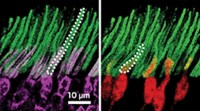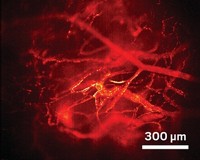Advertisement
Grab your lab coat. Let's get started
Welcome!
Welcome!
Create an account below to get 6 C&EN articles per month, receive newsletters and more - all free.
It seems this is your first time logging in online. Please enter the following information to continue.
As an ACS member you automatically get access to this site. All we need is few more details to create your reading experience.
Not you? Sign in with a different account.
Not you? Sign in with a different account.
ERROR 1
ERROR 1
ERROR 2
ERROR 2
ERROR 2
ERROR 2
ERROR 2
Password and Confirm password must match.
If you have an ACS member number, please enter it here so we can link this account to your membership. (optional)
ERROR 2
ACS values your privacy. By submitting your information, you are gaining access to C&EN and subscribing to our weekly newsletter. We use the information you provide to make your reading experience better, and we will never sell your data to third party members.
Materials
Fluorescent Nanoparticles Fresh From The Microwave
Biological Imaging: Researchers report a faster, more eco-friendly synthesis method
by Jeffrey M. Perkel
November 3, 2011

In recent years, so-called upconversion nanoparticles doped with rare-earth elements have attracted interest as stains for biological imaging and even potentially as anticancer therapeutics. But to synthesize them, researchers have relied on some pretty extreme conditions – 24 hours at 300 °C in the absence of water and oxygen, for instance. Now scientists show they can whip up a batch in about an hour, in a microwave oven. (Langmuir, DOI: 10.1021/la204015m)
When irradiated with short-wavelength light such as ultraviolet light, most fluorescent molecules emit light at a longer wavelength, such as visible light. Upconversion nanoparticles, though, are different: Upon excitation with long-wavelength, near-infrared light, they fluoresce at a shorter wavelength, in the visible spectrum.
Chuanbin Mao, professor of chemistry at the University of Oklahoma, Norman, explains that this property makes the nanoparticles useful for imaging biological samples. Compared to short-wavelength ultraviolet light, near-infrared light, Mao says, can penetrate cells and tissues more efficiently, with less scattering, and less damage to cells.
To make the particles, Mao, with Shukun Xu and colleagues in China, mixed acetates of the rare earth elements yttrium, ytterbium, and erbium; NH4F; and NaCl in the microwave at 160 °C for one hour. The resulting nanoparticles, he says, are comparable in quality to those made under more stringent conditions. The researchers then attached the nanoparticles to antibodies and used the resulting complexes to label cells in a petri dish. How they will fare in vivo remains to be seen, Mao says.





Join the conversation
Contact the reporter
Submit a Letter to the Editor for publication
Engage with us on Twitter